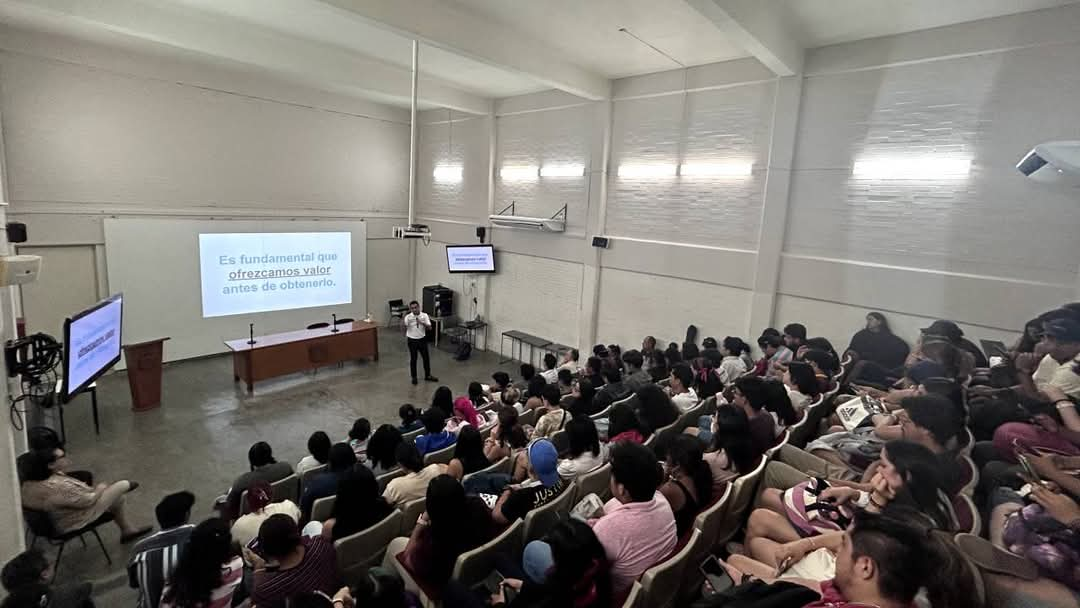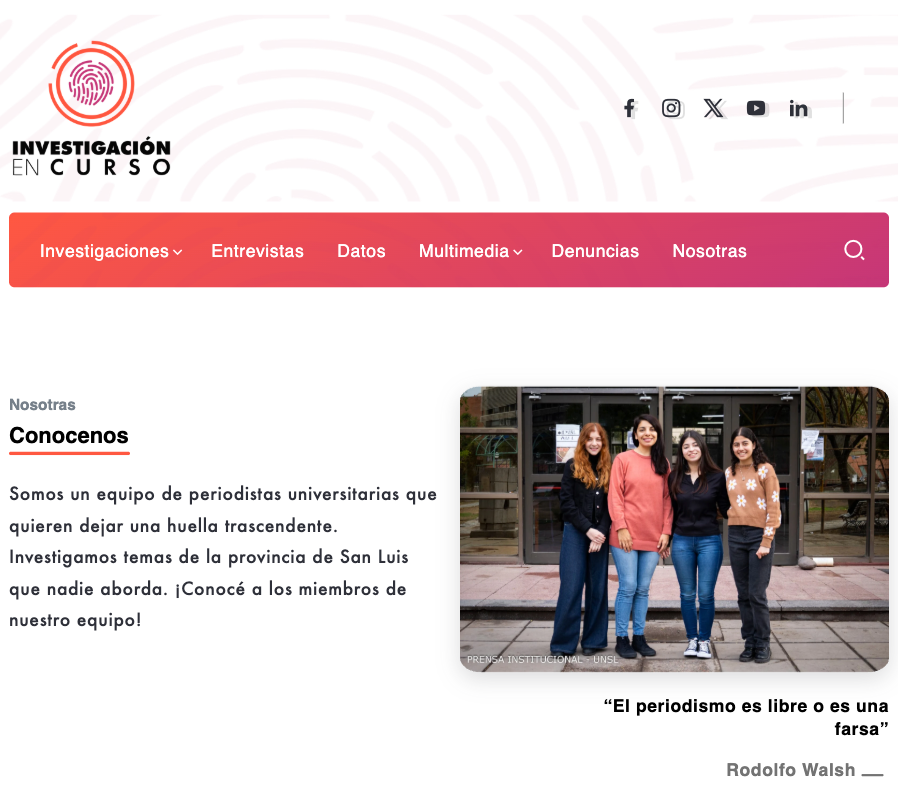Over 10 weeks, students from four Argentine provinces learned about ideation, product thinking, sustainability, business models, audience-centric design, branding, pitching and management, among other topics, as part of the first edition of University Media Laboratory, or LABU, an initiative from digital support organization SembraMedia.
Guided by mentors and their professors –who also received training on teaching entrepreneurial journalism– the teams worked from October to December 2024 to develop a minimum viable product (MVP). The winning project, which came from a team from San Luis, was an investigative journalism outlet called “Investigación en Curso.”
“Instructor support is a differentiator,” Gamarí Ramos Sánchez, project manager for SembraMedia's education department, told LatAm Journalism Review (LJR). “For teams who had closer participation of instructors… [the support] was a differentiator when it came to developing their MVP prototypes.”

Students attend a class taught by Abraham Torres, journalist and SembraMedia ambassador in Mexico. Torres highlighted the importance of keeping professors up to date with entrepreneurship in journalism. (Photo: Courtesy of Abraham Torres)
Experiences like LABU, whose second edition kicks off in May with students from Bolivia, demonstrate the growing interest in journalism entrepreneurship at Latin American universities and the important role of professors.
Between 2017 and 2022, entrepreneurial journalism courses in Spanish-speaking countries increased by 15 percent, according to “Starting Point II,” a study by SembraMedia.
“We realized that starting in 2019, when we started talking about this topic and sharing it with professors, they began to raise the issue at their universities so that at least one of these subjects could be included in the curriculum of communications programs,” Abraham Torres, a journalist and academic specializing in entrepreneurial journalism and SembraMedia ambassador in Mexico, told LJR.
Instructors in the region told LJR that teaching the business of journalism is a necessary skill, especially in the face of financial crises, media concentration and the rise of underserved audiences.
Yet, they agree that teaching entrepreneurial journalism skills faces limitations in terms of time, resources and professional development. They also said structural changes within universities are necessary for the teaching of these subjects to have a positive impact on the future of journalism.
Argentina, Colombia and Mexico are the countries where universities have incorporated the most courses related to entrepreneurial journalism, according to “Starting Point II.” They are also the countries with the largest number of digital startups, according to the media directory from SembraMedia.
Argentina, along with Ecuador and Spain, was a pioneer in offering journalism entrepreneurship courses since the last century, according to the SembraMedia report.
The economic crisis of the 2000s in Argentina encouraged workers to recover and self-manage companies and factories as a means of economic survival. This planted the seed of self-management in other industries, including media.
India Molina, a journalist and director of the journalism program at ETER School of Communication, a professional technical institute in Buenos Aires, said that traditional media were also failing to represent the interests of society.
“We had never thought of information as part of a productive system, and all these realities made us realize that we were,” Molina told LJR. “As a result of these self-managed worker experiences, they began to think that the media could also be self-managed and managed by the workers themselves, with the interests and agenda of the working class.”
Molina began teaching media self-management at the university level in 2013.
Laila Abu Shihab, co-founder of the Colombian investigative journalism outlet Vorágine and a professor at Externado University of Colombia in Bogotá, said that after completing a 2020 training program on entrepreneurial journalism for Ibero-American professors offered by SembraMedia, she suggested that her university create a course on journalistic entrepreneurship.

Investigación en Curso is an investigative journalism site created by university students from the province of San Luis, Argentina, as part of SembraMedia's LABU initiative. (Photo: Screenshot)
“After that training with SembraMedia and the launch of Vorágine, I noticed that other universities were starting to create courses on journalistic entrepreneurship,” Shihab told LJR. “I remember telling the dean, ‘It can't be that in 2022, students won't have the opportunity to learn to be entrepreneurs.’ And she sort of dismissed it; she didn't see the need for it.”
In July 2022, a new dean gave the green light to the idea and asked Shihab to design the course. This is how the Creation of Journalistic Businesses, which Shihab continues to teach to this day, emerged. The journalist said that most universities in Bogotá with social communication and journalism programs have a similar course.
“In 2019, 2020 or even in 2021, having a course on journalistic entrepreneurship was unusual; it was somewhat risky,” Shihab said. “The fact that universities in Colombia are really taking an interest in this topic has been going on for about the last five years.”
Although the conviction of the need to teach these subjects continues to grow, university bureaucracies and processes prevent curricula from updating at the pace required by the reality of journalism, Molina and Torres agreed.
In Mexico, for example, public universities take between eight and ten years to update their curricula, said Torres, who is president of Mexico's National Council for the Teaching and Research of Communication Sciences (CONEICC). Some haven't even changed their curricula in 20 years, he added.
"If institutional governance doesn't understand the dynamic changes that not only the industry, but also all of communications and journalism, are undergoing, it will be very difficult to make structural changes at the degree level," Torres said.
This means that many journalism programs continue to train professionals to seek work in major media outlets, while fewer and fewer students in the classroom want to work as employees, Shihab said.
“Students today genuinely have an interest in entrepreneurship because fewer and fewer want to be employees and do internships, for example, in traditional media in Colombia,” she said. “Many of them also come to the class because of this trend of starting their own business and being their own boss. But this goes beyond a trend and needs to be made sustainable.”
Other challenges facing journalism entrepreneurship instruction in Latin America include instructors who must constantly update skills, some who are forced to juggle multiple jobs in addition to teaching duties, and a shortage of professors with professional experience in media entrepreneurship.
The “Starting Point II” report indicated that technology, the dynamics of information and the crisis in journalism require a constant review of technical skills and technological modernization, which not all professors can afford.
“A professor who isn't up-to-date will have a hard time helping students or providing them with the content they need for their education,” Torres said. “A student who enters now in August 2025 will graduate from university in 2029. If a journalism professor doesn't know what will happen in 2029, or what changes will occur in the industry, then we'll have a hard time educating students who can cope with that reality.”
Additionally, 51 percent of the professors surveyed for “Starting Point II” reported having a job in addition to teaching. Of these, only 13 percent run their own media outlet. Among the most frequently mentioned additional activities are consulting, research and media employment.
Shihab said there's a growing need in classrooms for journalism entrepreneurship professors to be professionals with personal experience creating news outlets.
The journalist said the knowledge she imparts in her class is based on the training she received with SembraMedia, but also on her own experience as the founder of Vorágine.
Hola estudiantes y profes comunicación y periodismo!
En @sembramedia los estamos buscando para un programa de formación y mentoría para crear productos periodísticos digitales.
Acá la info: https://t.co/MqLMka0agR
Cualquier cosita, a sus órdenes! pic.twitter.com/Ortwhp6U2Y
— Fabiola Gutiérrez (@lafa149) April 22, 2025
“At first, those teaching this course were very thoughtful journalists who might have even had a career in journalism, but who didn't know what entrepreneurship meant, that they were employees,” Shihab said. “Now it's becoming clear that what students are demanding is that those teaching these courses at universities bring practical experience from their own entrepreneurial experiences.”
Molina said that, from what she's observed, more and more professors in Argentina have or have had self-managed experiences in media. In her opinion, this experience is important because it adds an inspirational element to the classroom.
“The syllabus includes sharing self-management experiences and not just presenting them with the business model canvas, the action plan… Of course, not to paint an ideal world, but also the challenges, opportunities, and needs,” Molina said. “Students hear these experiences from their professors, and that enthusiasm is contagious. [...] What these generations do understand earlier is how things are in general and that it is possible to do it.”